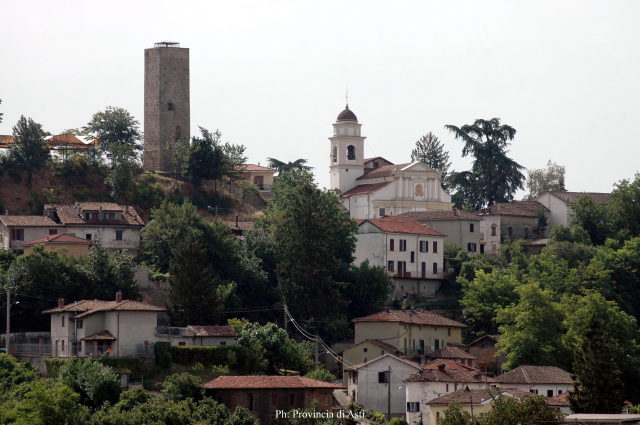Cassinasco
Last update 30 January 2024
The gateway of the Langa of Asti “wounded” by the fury of the French: Cassinasco, where Pavese dreamed of seeing the sea
Landscape
Cassinasco is defined as the gateway to the Langa of Asti.
It is about 34 Km from the provincial capital, Asti.
Insights
“Sentieri”. Comune di Cassinasco, Apr. 12, 2018, www.comune.cassinasco.at.it/it/page/sentieri. Last accessed Jan. 12, 2024.
History
The origins of Cassinasco
The village is said to have been founded by a tribe of Ligurians.
Roman period
Roman domination leaves traces in the presence of housing structures that historians date back to the 1st century AD.
Early Middle Ages
Cassinasco passed under the rule of Marquis Aleramo of Monferrato, then the Alessandrini and the Astigiani; the latter were finally forced to return it to its previous masters.
The town then goes through the period of Guttuari and Sforza rule.
1615
Cassinasco is the scene of furious clashes between the men of the Duke of Savoy and the local population. The consequences are obvious: the French, allies of the House of Savoy, burn the village and destroy the castle, of which only a splendid tower remains visible in our days.
After the violent destruction, the village entered the Savoy possessions.
Insights
“Storia”. Comune di Cassinasco, Apr. 11, 2018, www.comune.cassinasco.at.it/it/page/storia-60b4ba34-a10b-4b6e-be12-5770dec3e61d. Last accessed Jan. 12, 2024.
Administration
Food and wine and typical products
Cassinasco is renowned for its sweets (especially amaretti and nougat).
Wine production is also important with the cultivation of the Muscat grape variety.
Insights
“Torrone”. Comune di Cassinasco, Apr. 11, 2018, www.comune.cassinasco.at.it/it/page/torrone. Last accessed Jan. 12, 2024.
To be seen
The remains of the ancient castle of Cassinasco, destroyed in 1615, are represented by a 20-meter-high square tower (open to visitors).
Nearby stands the parish Church of St. Hilary of Poitiers (Chiesa di Sant'Ilario di Poitiers).
Isolated, however, is the Church of St. Hilary (Chiesa di Sant'Ilario).
Furthermore, worth seeing is the Church of St. Maximus (Chiesa di San Massimo), the Caffi's Sanctuary (Santuario dei Caffi), and the Chapel of St. Anthony (or of the Gibelli) — Cappella di Sant'Antonio (o dei Gibelli).
Finally, among the vineyards of the Cà ed Cerutti winery, we find a giant light blue bench.
Insights
“Cappella dei gibelli”. Comune di Cassinasco, Apr. 11, 2018, www.comune.cassinasco.at.it/it/page/cappella-dei-gibelli. Last accessed Jan. 12, 2024.
“L'antica chiesa di Sant' Ilario”. Comune di Cassinasco, Apr. 11, 2018, www.comune.cassinasco.at.it/it/page/l-antica-chiesa-di-sant-ilario. Last accessed Jan. 12, 2024.
“La Torre”. Comune di Cassinasco, Apr. 11, 2018, www.comune.cassinasco.at.it/it/page/la-torre. Last accessed Jan. 12, 2024.
“Punti di Interesse”. Comune di Cassinasco, www.comune.cassinasco.at.it/it/point-of-interests. Last accessed Jan. 12, 2024.
“San Massimo”. Comune di Cassinasco, Apr. 11, 2018, www.comune.cassinasco.at.it/it/page/san-massimo. Last accessed Jan. 12, 2024.
“San Sebastiano”. Comune di Cassinasco, Apr. 11, 2018, www.comune.cassinasco.at.it/it/page/san-sebastiano. Last accessed Jan. 12, 2024.
“Storia”. Comune di Cassinasco, Apr. 11, 2018, www.comune.cassinasco.at.it/it/page/storia-60b4ba34-a10b-4b6e-be12-5770dec3e61d. Last accessed Jan. 12, 2024.
Curiosity
The medieval, stone tower that belonged to the ancient castle of Cassinasco still bears the “scars” of the violent fighting of 1615: a deep gash that pierces it.
Insights
“Storia”. Comune di Cassinasco, Apr. 11, 2018, www.comune.cassinasco.at.it/it/page/storia-60b4ba34-a10b-4b6e-be12-5770dec3e61d. Last accessed Jan. 12, 2024.
Data source
- Synthesis / reprocessing information taken from the institutional website (current and previous versions) of the Municipality of Cassinasco — https://www.comune.cassinasco.at.it/
- Cover image source: Provincia di Asti — https://www.provincia.asti.it
Insights
BeWeb - Beni Ecclesiastici in WEB
https://beweb.chiesacattolica.it/
Catalogo Generale dei Beni Culturali
https://catalogo.beniculturali.it/
Centro Interuniversitario di Storia Territoriale "Goffredo Casalis"
https://www.archiviocasalis.it/
Ente Turismo Langhe Monferrato Roero
https://www.visitlmr.it
Wikipedia, l'enciclopedia libera.
https://it.wikipedia.org
- Cassinasco
https://it.wikipedia.org/wiki/Cassinasco
See also
News from Cassinasco
- Discover the latest news posted on the website of the Municipality of Cassinasco
https://www.comune.cassinasco.at.it/it/news
Events in Cassinasco
- Discover the events posted on the website of the Municipality of Cassinasco
https://www.comune.cassinasco.at.it/it/events

